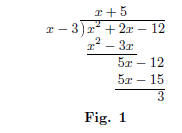Synthetic Division
Abstract
This handout is a supplement to Section 10.8 of the textbook used in my Math
100 class. The material
here is not discussed in the textbook.
What is synthetic division ?
In Section 10.8 of our textbook, we discussed long division of polynomials.
For example, using long division,
we found that

For certain types of polynomial division problems , there is an easy method known
as synthetic division,
which yields the quotient very quickly. As we mentioned in lecture, synthetic
division also has an extremely
useful application, which we examine here as well. Let us begin by finding a
quotient of two polynomials
with long division.
Example 1. Let us perform the division indicated by
 Using long division as we did in lecture,1
Using long division as we did in lecture,1
we obtain the result in Figure 1.

Hence,
Using synthetic division, we use only the coefficients of the polynomial x2
+2x−12 and the opposite of the
−3 in the polynomial x − 3.
Example 2. Use synthetic division to perform the polynomial division indicated
by  We write 3 (the
We write 3 (the
opposite of the −3 in x−3) and the coefficients of x2 +2x−12 in a
row, and then we box off the numbers as shown
in Figure 2.

The first step is to bring the 1 straight down as shown in Figure 3.

Next, multiply the 3 by the 1 on the bottom row, and write the result in the
blank spot just below the 2.

Add the 2 and 3, and write the result in the same column.

Multiply the 3 and the 5, and write the result in the spot just below the −12.

Finally, add the −12 and the 15, and write the result in the same column.

Notice that the last line “1 5 3” gives the coefficients and the remainder that
we are seeking. That is, the last
line “1 5 3” means x + 5 with a remainder of 3. Thus,

which is precisely the answer we obtained when we used long division of
polynomials.
How do we know that the “1 5 3” does not mean x2 + 5x + 3? The
polynomial which we are dividing is of
degree 2, so the quotient is a polynomial of degree 1 less than that.
When does synthetic division work?
Synthetic division can only be used when one is dividing by a polynomial of
degree 1 and which has a leading
coefficienct of 1. For example, synthetic division can be used to do the
division problems
 and
and

because we are dividing by x + 1 and x − 10, respectively. On the other hand, we
cannot use synthetic
division in the division problems
 and
and

because the coefficient of x is 3 in the first problem and because we are
dividing by a second-degree polynomial
in the second problem. To understand why this is the case, let us see why
synthetic division works.
Why does synthetic division work?
Synthetic division is nothing magical. It is long division. It works quite
simply because we are dividing by
a polynomial of degree 1 with leading coefficient 1. Synthetic division really
is the act of writing down only
the essential parts of long division. Let us put Example 1 and Example 2 side by
side to see this.
Example 3. Let us perform the division indicated by
 We show the long division steps on the left
We show the long division steps on the left
and the accompanying synthetic division step on the right in each figure. First,
we write the problem so that we can
start the division processes.

Step 1 Setting up the division.

Step 2 Bringing the 1 straight down is really writing the
x in the quotient. The 1 is the coefficient of x; i.e., the 1
is really shorthand for 1x.

Step 3 Multiplying the 3 by the 1 is the same step as multiplying the x by the x
− 3, except that we are really only
writing down the term −3x and not writing down the x2 term since it
is going to cancel in this step.

Step 4 Since the leading coefficient of x − 3 is 1, we know we are going to have
to multiply x − 3 by 5 to obtain the
5x in the 5x − 12. Thus, when we add the 2 and the 3 in synthetic division, we
are simultaneously doing two steps
in the long division process: subtracting the x 2 − 3x from the x2
+ 2x (We don’t write the x2 terms in the synthetic
division steps since they cancel anyway.) and writing the +5 in the quotient.

Step 5 Multiplying the 3 by the 5 in synthetic division is the same as
multiplying the 5 by the x − 3 in long
division and writing the 5x − 15.

Step 6 Adding the −12 and the 15 in synthetic division is the same as
subtracting the 5x − 15 from the 5x − 12
(i.e., 5x − 12 − (5x − 15) = −12 + 15) in long division. In both processes we
obtain the remainder of 3.
Exercise. Do the division indicated by  Use
both long division and synthetic division, and write
Use
both long division and synthetic division, and write
the matching steps for each side-by-side as in Example 3.
| Prev | Next |